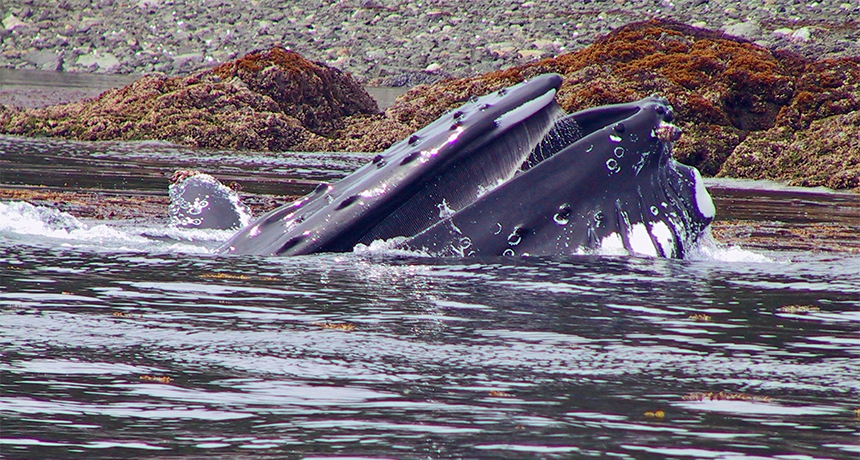Whales feast when hatcheries release salmon
Crowds of young fish at release sites may attract hungry humpbacks to a new type of prey

Crowds of prey make eating small fish worth the effort for huge humpback whales. This also may help explain a whale innovation: dining on young salmon released by fish hatcheries.
David Csepp, NOAA/NMFS/AKFSC/ABL, National Oceanic and Atmospheric Administration/Department of Commerce
By Susan Milius
Some Pacific humpbacks have discovered a new source of convenience food.
After wintering in the tropics, these whales migrate every spring to feeding grounds in southeastern Alaska. Now, some have added a new Alaskan dining destination. They visit fish hatcheries as they are releasing young salmon into the sea, researchers report.
It’s an unusual behavior for the whales. Scientists say this is the first time humpbacks anywhere have been seen eating young salmon (SAA-mun).
The whales are “40 feet [12 meters] long and they’re feeding on fish that are the size of my finger,” says Ellen Chenoweth. She works at the Juneau Center of the fisheries department of the University of Alaska Fairbanks. As a marine ecologist, she studies how humpbacks find food. For such small prey to be worth eating, the big whales need to find a lot in one place. Young salmon streaming out of hatchery nets seem to fit the bill.
Chenoweth and her colleagues worked with the staff at five hatcheries to observe whales. All the hatcheries were near Baranof Island in southeastern Alaska. Over six years, the team recorded whether whales were around before, during and after young salmon were released. A trend emerged of humpbacks showing up at spring fish releases.
Humpbacks have a reputation for diverse and flexible diets, Chenoweth says. The salmon feasts show them adapting to a new source of prey. Her team published its findings July 12 in Royal Society Open Science.
Big gulps
Hatcheries raise the young salmon and release them to the ocean. The hope is that many will survive to become adults. This should boost the number of adult salmon available to fishing fleets. Whether whales eat enough to spoil that plan remains unknown, the scientists now say.
One upside for scientists of these whale feasts is already clear. Hungry whales in shallow water gives them a rare chance to film humpbacks dining. To catch the tiny salmon, the whales blast headfirst into their dinner. This technique is known as lunge feeding. It’s dramatic, but often hard to study.
Like a school bus going crazy, a humpback opens its jaws and speeds toward a cluster of fish. The whale then gulps a giant mouthful of fish-filled water. To allow for the biggest gulp, the whale throat swells “like a parachute opening,” Chenoweth explains.
One gulp is truly a whale of a mouthful. In a single lunge, a humpback may take in some 27,600 liters (7,300 gallons) of seawater. An amount like that is equal to about 28 metric tons (62,000 pounds). That’s enough to temporarily double the whale’s weight!
Humpback whales have no teeth. Instead, their mouths are filled with dangling fringes of what’s called baleen. As the whale swooshes the water back out, the hanging baleen snags what’s worth swallowing. For these whales, those bits add up to a salmon dinner.
Studying monster lunges is hard because humpbacks often dive deep to feed, Chenoweth notes. Scientists in a boat at the surface can’t see what gets swept in far below. They just glimpse whales back at the surface huffing to catch their breath before the next exciting plunge.
“It’s like going to a basketball game but you can only really watch players on the bench,” Chenoweth says. But when whales lunge at salmon in shallow water —such as during hatchery releases — a camera on a pole can capture the frenzy of this feast.
E. Chenoweth et al/Royal Society Open Science 2017; NOAA fisheries permit #14122







